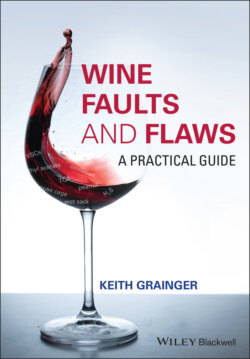Читать книгу Wine Faults and Flaws - Keith Grainger - Страница 20
1.8 Sensory Detection (Perception) Thresholds and Sensory Recognition Thresholds 1.8.1 Sensory Detection Thresholds
ОглавлениеThere are many compounds that may give rise to faults but, with the notable exception of TCA and other haloanisoles, their presence usually only becomes important when their concentration is at or above, or has the potential to reach, their individual sensory detection thresholds. To complicate matters, there are also some compounds which, even if below their individual sensory detection thresholds, may produce off‐odours or‐off‐tastes if present with other compounds, which may also be below their individual sensory detection thresholds.
Sensory perception thresholds may be divided into odour detection thresholds (ODTs) and taste detection thresholds (TDTs), but many authors and researchers do not distinguish between these. A simple definition of a sensory perception threshold is ‘the level at which the aroma, flavour, taint, or fault will be detected by the 50% of the general public’. An alternative definition is ‘the lowest concentration at which individuals can reliably perceive a difference between a sample and its corresponding control, with 50% performance above chance’ [13]. Of course, individuals vary markedly in their perception thresholds to aromas and tastes. Threshold values may be stated for detection in air, water, wines generally, red, white, or sparkling wines, and even wines made from individual grape varieties or in different styles, such as light‐ or full‐bodied. However, the determination of such thresholds is perhaps far from a precise science, and individual research papers will often state markedly differing figures. The ‘Triangle Test’ is one widely used method of determining the sensory detection thresholds of compounds in wine and foodstuffs generally and is included in the methodology of the Society of Sensory Professionals. In this method members of a panel are presented with three samples: one different from the two identical. All three samples should be presented to each panel member at the same time, and the samples are tasted from left to right. There are six possible order combinations, and these should be randomised across panel members [16]. There is an ISO standard for measuring sensory detection thresholds by a three‐alternative forced‐choice (3‐AFC) procedure: ISO 13301 (2018) [17]. ASTM International, formerly known as the American Society for Testing and Materials (ASTM) has produced document E679‐04 (2011): Standard Practice for Determination of Odor and Taste Thresholds by a Forced‐Choice Ascending Concentration Series Method of Limits [18].
